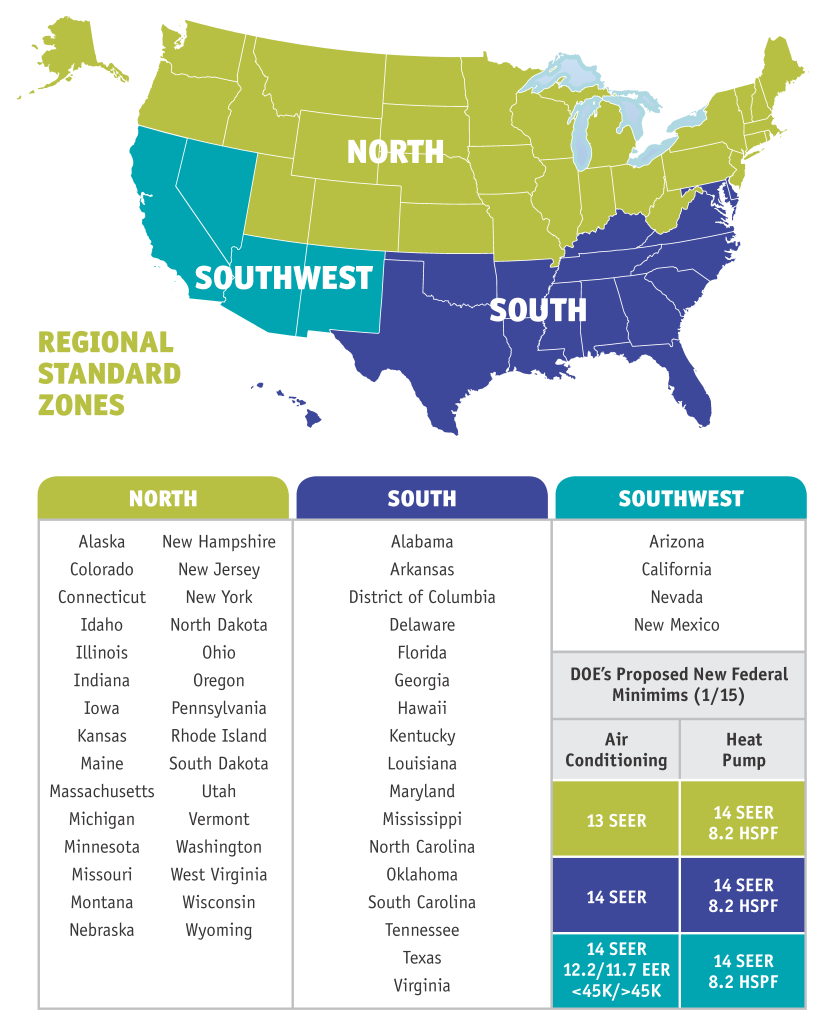New Govt. Regulations for HVAC Efficiency
The DOE also has a state-level goal of adopting the 2009 International Energy Conservation Code (2009 IECC). The set baseline for energy efficiency in residential and commercial buildings will be implementing stricter standards until 2030. As these codes become effective through new regulation, manufacturers and contractors will need to build and install progressively more efficient systems and components. So, how does this affect you, the homeowner?
On January 1st of this year, new regulations increasing the minimum efficiency ratings required on all new air conditioners and heat pumps were released by the US Department of Energy (DOE). These regulations also affect existing HVAC equipment as well; a “matching” requirement for HVAC equipment states that when the existing one can not be repaired with “like-kind” parts, all components (existing and new) must be compatible with the same efficiency rating as a newly manufactured system. So, if you need to completely replace your system, it must comply with the new energy efficiency regulations, or, if you are simply replacing parts to repair an existing system, they too, must meet the new standards.
What’s a SEER and what does it have to do with my HVAC system?
A SEER is the Seasonal Energy Efficiency Ratio, a measurement of energy efficiency. The Air Conditioning, Heating and Refrigeration Institute (AHRI) defines this metric by dividing the unit’s cooling output during a normal cooling season with the total electric energy input. Simply put, a higher SEER rating means that an air conditioner is more efficient. In 2006, the federal government mandated that 13 SEER equipment be the new minimum SEER rating for all new central air conditioners. Now, all new equipment in certain regions of the U.S. will be required to have a SEER rating of at least 14. In some parts of the country, heat pumps will be required to have a SEER rating of at least 14 and a HSPF rating of 8.2 (or 8, for packaged heat pumps.)
To implement this new regulation, the DOE has divided the country into three regions, and each region will have unique requirements for air-conditioner and heat pump efficiency levels. This is the first time that efficiency standards for HVAC components will be determined on a regional basis. The three regions, the North, Southeast, and Southwest, were determined by analyzing each region’s heating degree days (HDD) and weighted for population. In the North, air conditioners must be at least 13 SEER and furnaces must now have an efficiency of 80% or more (prior to the new regulations, the national standard was 78% efficiency). While it is acceptable in the North to install 13 SEER units, no 13 SEER units can be manufactured after January 1, 2015. In the Southeast and Southwest, 14 SEER is the new requirement for air conditioners, and furnaces must be at least 80% efficient. The DOE has granted a grace period where 13 SEER equipment may be installed anywhere in the country up until June 30, 2016.
A: Residents of Northern states will use less energy to cool their homes and more energy to heat their homes than residents of states in the Southeast and Southwest.
The bottom line in processing the new regulations and making sense of them, is to ensure that you perform annual “check-ups” on your HVAC systems and heat pumps. If you think your systems are aging out, consider asking a professional about its life expectancy to better assess replacement and/or repair. Also, if your equipment is nearer to needing repair or replacement, research purchasing a home warranty service to help plan for the future and mitigate costs.

